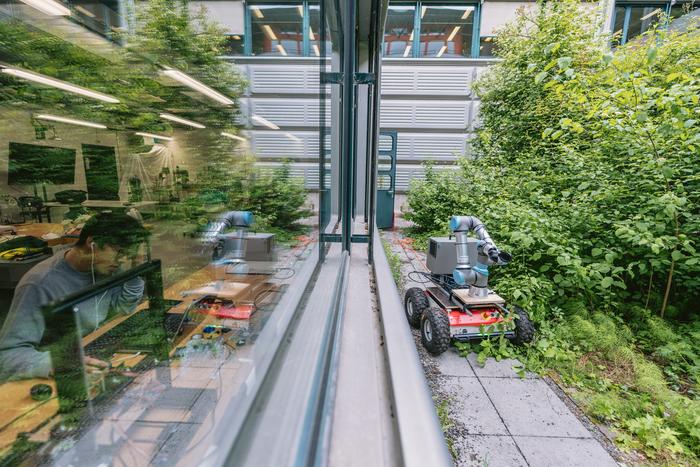TL;DR:
- TU Delft and EPFL researchers explore whether ChatGPT can design a robot, focusing on food supply challenges.
- ChatGPT provides valuable insights during the conceptual and implementation phases of designing a tomato-harvesting robot.
- The collaboration between humans and AI leads to the creation of a robotic arm for efficient tomato harvesting.
- Researchers discuss the varying degrees of cooperation between humans and large language models (LLMs) like ChatGPT.
- Challenges include the risk of misinformation, bias, and ethical concerns in utilizing LLMs for robot design.
- Ongoing research examines the role of LLMs in assisting robot developers while preserving creativity and innovation.
Main AI News:
In a fascinating collaboration, researchers from TU Delft and the Swiss technical university EPFL joined forces to explore the capabilities of ChatGPT, an open AI platform. Their goal was to determine whether ChatGPT could design a robot, while also considering the implications and risks associated with such an endeavor. The outcomes of their innovative project were recently published in Nature Machine Intelligence.
The researchers, led by Cosimo Della Santina, assistant professor at TU Delft, along with PhD student Francesco Stella from the same institution and Josie Hughes from EPFL, began by posing a fundamental question to ChatGPT: What are the greatest challenges that humanity will face in the future? From there, they sought ChatGPT’s assistance in designing a robot that would not only be inventive but also serve a practical purpose. The team eventually settled on the idea of creating a robot dedicated to tomato harvesting.
Throughout the design process, the researchers carefully considered and implemented ChatGPT’s suggestions. According to Stella, ChatGPT’s insights proved invaluable, particularly during the conceptual phase. The AI platform offered expertise in various areas, enabling the researchers to expand their understanding. In fact, ChatGPT even advised them on the most economically viable crop to automate, highlighting its potential to extend knowledge beyond the designers’ field.
Additionally, ChatGPT made significant contributions during the implementation stage. For instance, the AI platform recommended constructing the robot’s gripper using silicone or rubber to prevent damage to the delicate tomatoes. It also identified the Dynamixel motor as the optimal choice for driving the robot. The fruitful collaboration between humans and AI resulted in the successful creation of a tomato-harvesting robot, featuring a robotic arm capable of efficiently gathering ripe tomatoes.
While the researchers found the collaborative design process to be enriching, they also noted a shift in their roles as engineers. Stella explained that they were required to focus more on technical tasks, indicating the evolving nature of human involvement in AI-driven design processes. In their publication, the researchers explored different levels of cooperation between humans and Large Language Models (LLMs), such as ChatGPT. They presented a scenario where AI takes the lead in providing input for robot design, with humans essentially serving as managers responsible for defining design objectives.
However, it is important to acknowledge the potential risks associated with such an extreme scenario. Della Santina cautioned that unverified or unvalidated output from LLMs could be misleading. AI-generated responses tend to prioritize the “most probable” answer, raising concerns about misinformation and bias in the field of robotics. Moreover, the utilization of LLMs raises significant issues related to plagiarism, traceability, and intellectual property, necessitating a comprehensive examination of ethical considerations.
Moving forward, Della Santina, Stella, and Hughes plan to continue their research on robotics by leveraging the tomato-harvesting robot. Simultaneously, they aim to deepen their understanding of LLMs to design innovative robots. Specifically, they are exploring the autonomy of artificial intelligence in developing their own physical structures. Stella concludes by highlighting the critical question facing their field: How can LLMs effectively assist robot developers without impeding the creativity and innovation necessary to tackle the challenges of the 21st century?
In their groundbreaking work, these researchers exemplify the power of collaboration between humans and AI. By leveraging the strengths of ChatGPT and augmenting their own expertise, they have pioneered the development of a tomato-harvesting robot. As the field of robotics advances, their continued exploration of LLMs promises to shed light on the delicate balance between AI assistance and human ingenuity, ultimately shaping the future of this dynamic industry.
Conclusion:
The collaboration between TU Delft researchers and ChatGPT in designing a tomato-harvesting robot demonstrates the potential of combining human expertise with AI capabilities. The fruitful partnership showcases the ability of AI to extend knowledge and provide valuable insights throughout the design process. However, careful consideration must be given to the risks of misinformation and bias, as well as ethical considerations such as plagiarism and intellectual property. As the market for robotics continues to evolve, the findings of this research emphasize the importance of striking a balance between AI assistance and human creativity to drive innovation in the 21st century.

